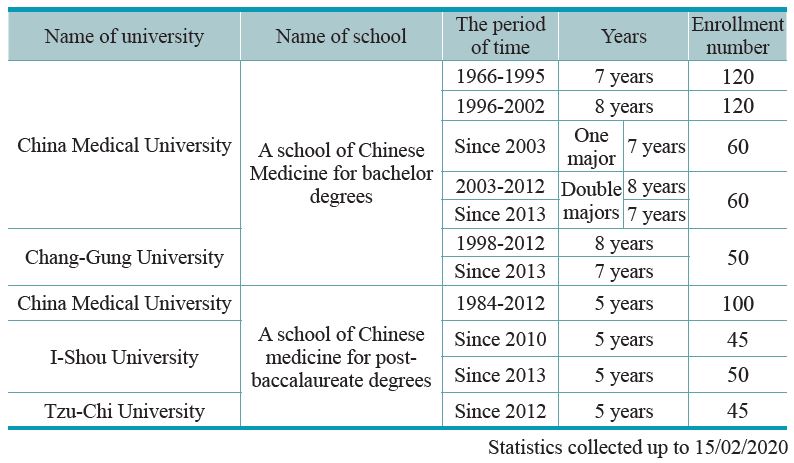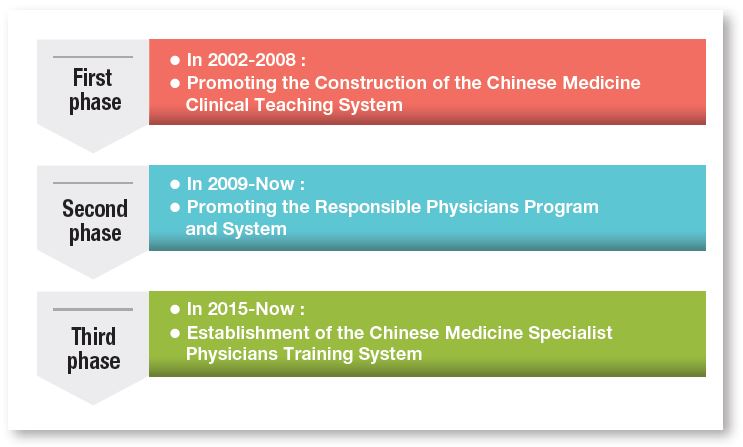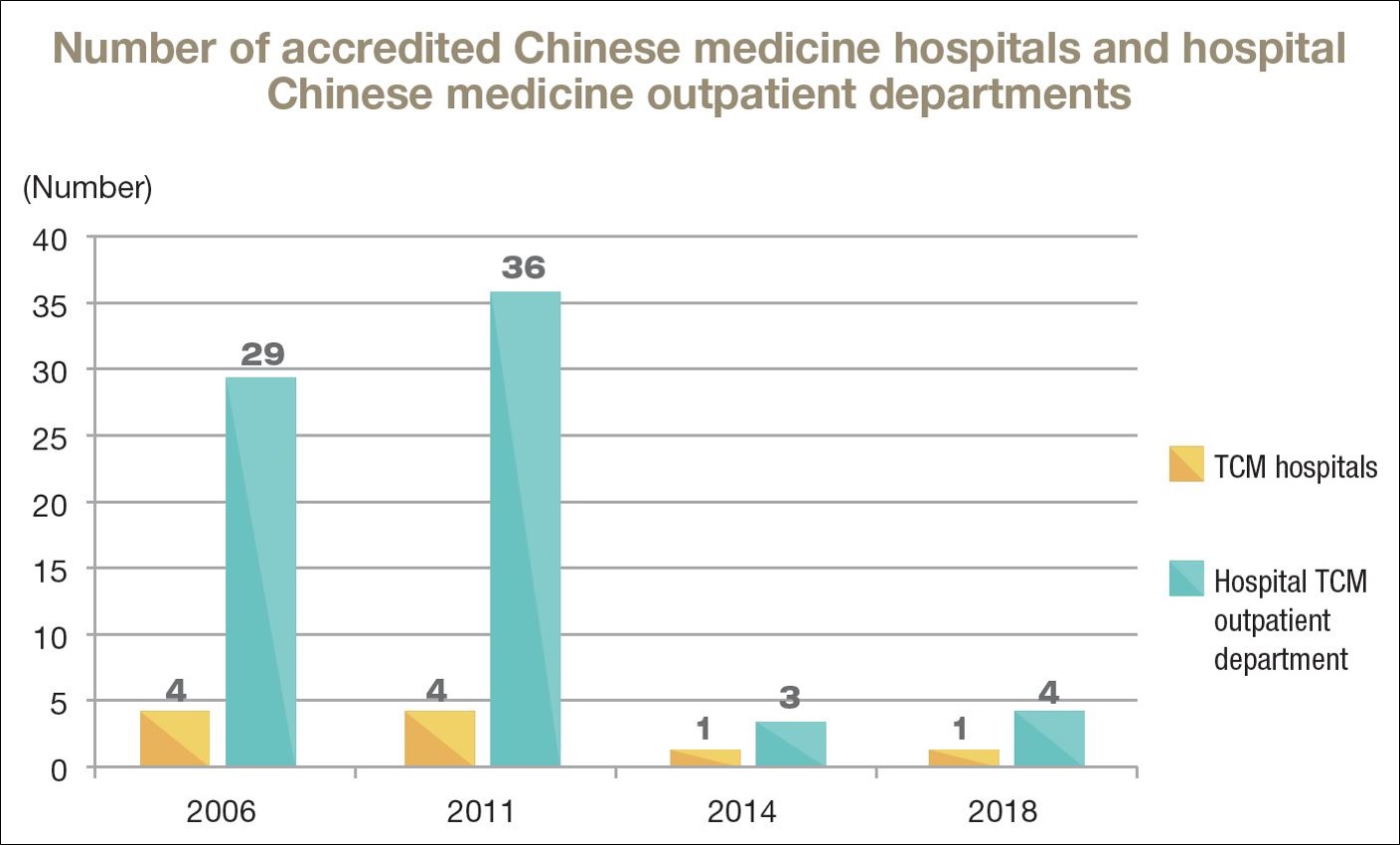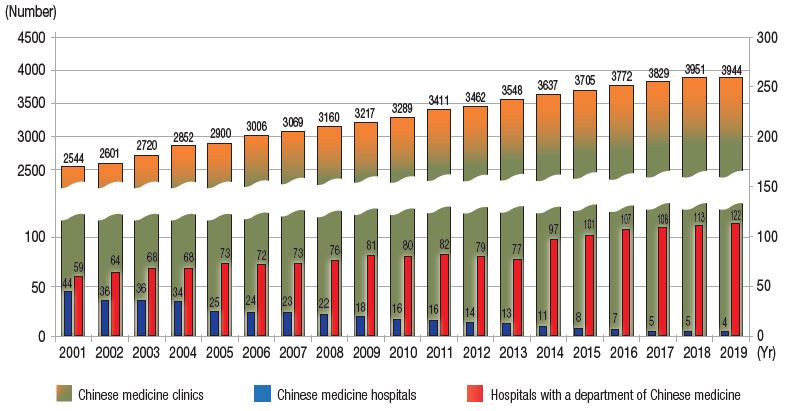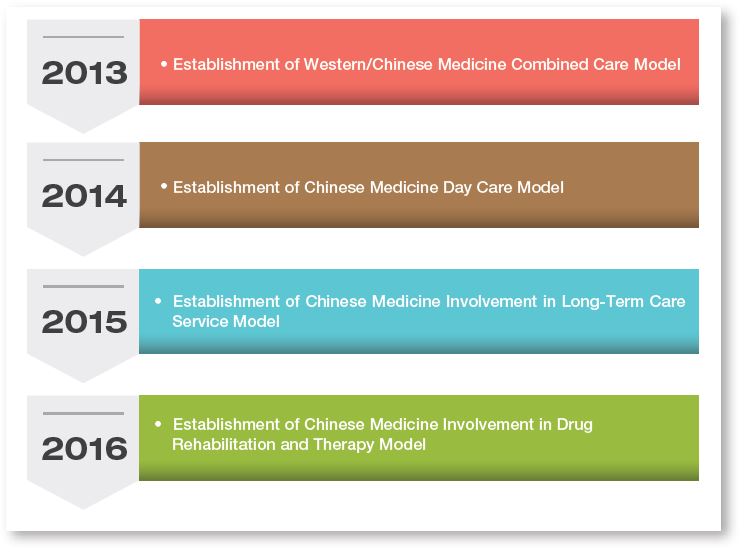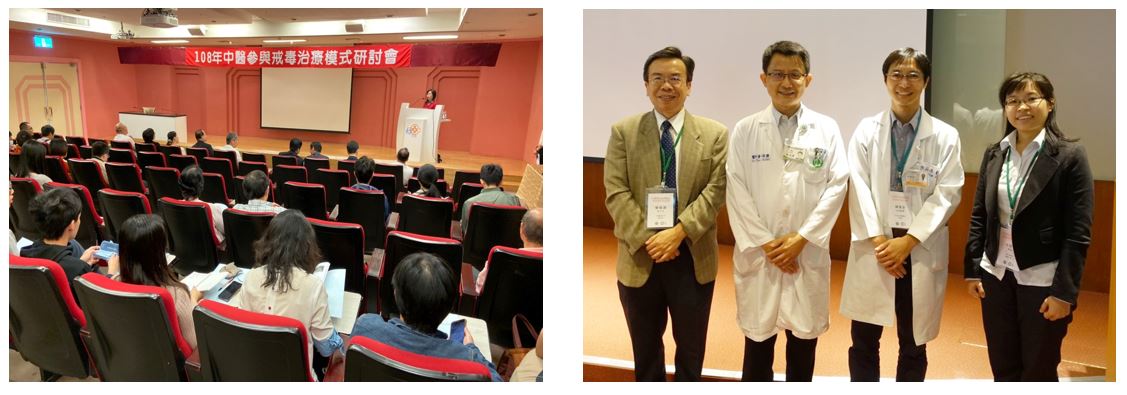There is growing demand from the public for health care and prevention following the changes in social-economic environment and population structures. Therefore, health care administration faces multiple new challenges. In particular, in recent years international health care and prevention communities have seen gradually increasing support for natural therapies. Chinese medicine administration is thus becoming progressively more important. We promote the quality of physicians and related services, as well as the development of Chinese medicine health care facilities in tandem, so as to increase the quality of Chinese medicine health care overall.
Section One: Education and Examination for Chinese Medicine Physicians
I. Human Resource Training for Chinese Medicine Physicians
China Medical University established the School of Chinese Medicine in 1966. Since then, Taiwan has had 5 schools of Chinese medicine at 4 universities: schools of Chinese Medicine for bachelor degrees at China Medical University and Chang-Gung University; and schools of Chinese Medicine for post-baccalaureate degrees at China Medical University, I-Shou University and Tzu-Chi University. Annually 365 modern Chinese medicine physicians are educated and trained to receive both western and Chinese medical knowledge. Table 2-1 roughly shows the duration of training and admission numbers for Chinese medicine education in each institution.
Table 2-1: Enrollment at Chinese Medicine schools in Taiwan
II. Chinese Medicine Physician-Related Examination
Before 2011, there were two categories of national examinations for obtaining the qualification of Chinese medicine physician. The first was an advanced examination for physicians of Chinese medicine to obtain the acknowledgment by passing a professional and technical examination. The second was a special examination for physicians of Chinese medicine to achieve a professional and technical [examination]. Candidates that completed a bachelor degree in Chinese medicine, or a qualified Western medicine physician who had completed a related Chinese medicine degree would be eligible for taking a senior examination for becoming a Chinese medicine physician. The special examination for Chinese medicine physicians was provided for people who self-studied or studied in non-professional tutorial schools and had passed a certifying examination in Chinese medicine. However, these people did not have fully modernized Chinese medicine training. In order to increase the quality of Chinese medicine physicians and ensure that professional training, teaching, and testing had been received by physicians, Article 3 in the Physicians Act was amended on 16 January, 2002. The examination system for Chinese medicine physicians would only be available through a university education. This meant that after 2011 people could only apply for the Chinese medicine physician examination after completing a university education. The special examination for Chinese medicine physicians was then officially terminated. Amendments to this policy were a positive step towards improving the quality of Chinese medicine physicians.
Section Two: Chinese Medicine Physicians for Clinical Training
I. Chinese Medicine Physician Clinical Training
The clinical training system was set up to improve the competency of Chinese medicine physicians. The implementation was divided into 3 phases to promote clinical tuitionary training of Chinese medicine physicians. The implementation plan for each phase is as follows:
- The first phase: "Chinese Medicine Clinical Teaching System Plan" was promoted during 2002-2008. Training teachers, locating facilities, establishment of the training models, developing plans, compiling educational materials, implementing of training and other fundamental works were completed gradually, to enrich teaching institutions'software and hardware equipment and resources.
- The second phase: "The Responsible Physicians in Chinese Medical Training Program and System" has been promoted since 2009. The Ministry has appointed qualified training facilities and has advised these facilities in order to enhance both the fundamental programs for incoming Chinese medicine physicians and their clinical competence in Chinese Internal Medicine, Gynecology, Pediatrics, Acupuncture and Traumatology. And they can choose to receive general Western medicine and emergency training. "The Training System of Responsible Physicians in Chinese Medical Care Institutions" was officially implemented in 2014. Now Chinese medicine physicians who would like to be responsible for Chinese medicine facilities must have two-year physician training in the training institute appointed by the Ministry, to cultivate Chinese medicine physicians with comprehensive medical skills.
- The third phase: The Ministry has researched and explored the possibility of a "Chinese medicine resident physicians training sessionin 2015. With the "Chinese medicine specialist physicians training system", it can cultivate Chinese medicine physicians with the ability to conduct empirical scientific research and specialized education. Figure 2-1 shows the results of promotion of Chinese medicine physician clinical training at each phase.
Figure 2-1: Design the blueprint for a Chinese medicine physician clinical training system
II. Continuing Education
1. Continuing Education for Chinese Medicine Physicians
According to Item 2, Article 8 in the Physicians Act, Chinese medicine physicians should pursue continuing education during practice. Also practice license renewal requires the certification of completed continuing education every 6 years. The Ministry announced "A plan for improving the practice quality of Chinese medicine workers" in order to carry out this policy effectively, and Chinese medicine organizations are subsidized to conduct continuing education activities each year. A total of 52 professional continuing education seminars were conducted during 2012-2019. A total of 6,109 Chinese medicine physicians participated in the activities. Figure 2-2 shows the snapshots of an activity.
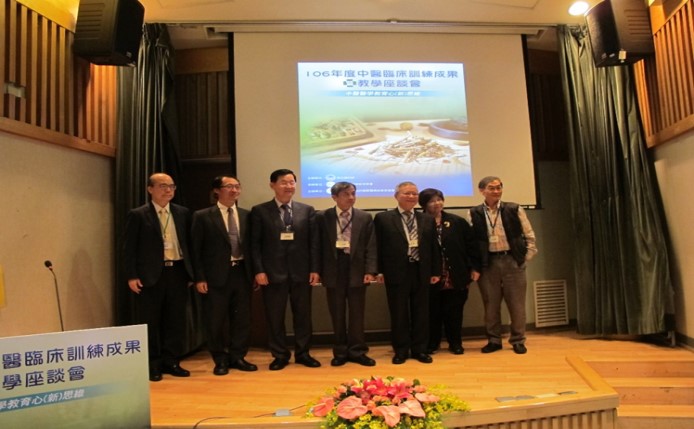
Figure 2-2: The situation of continuing education activities for Chinese medicine physicians
2. Chinese Medicine Nursing Training
According to article 24.1.4 of the Nursing Personnel Act, nursing personnel can perform Chinese medical assistance activities. Universities and colleges with nursing departments have been encouraged to open a Chinese medicine nursing curriculum. The Ministry set the "Guidelines of Elective Subjects and Credits for Chinese Medicine Nursing Training" in 2000 (there are 7 subjects and 9 credits; including general knowledge of Chinese medicine, general knowledge of Chinese pharmacy, Chinese medicine cuisine, acupuncture nursing, trauma nursing, Chinese medicine nursing and practical training for Chinese medicine nursing). Nursing organizations are subsidized to conduct Chinese medicine nursing training each year. A total of 3,166 nurses completed the "7 subjects and 9 credits" training programs by the end of 2019. Figure 2-3 shows a snapshot of the training. In order to standardize Chinese medicine nursing technology, since 2017 the nursing team has been counseled to develop operating specifications for Chinese medicine nursing technology for hospital nurses to perform activity.
Figure 2-3: Chinese medicine nursing training
Section Three: Improving the Quality of Traditional Chinese Medicine Health Care
I. The establishment of the accreditation system for Chinese Medicine Hospitals and Chinese Medicine Outpatient Departments in hospitals
To build a patient-centered, safe, and high-quality Chinese medicine health care system, the Ministry has promoted the visit plan of the "Chinese Medicine Hospitals and Chinese Medicine Outpatient Departments" since 2003. Starting 2006, the Ministry stipulated hospital accreditation standards to implement the "Chinese Medicine Hospitals and Chinese Medicine Outpatient Department Accreditation". The accreditation standards include 2 sections: Operational Management and Medical Care, together consisting of 196 items. By the end of 2018, 5 such accreditations had been organized, and there are currently 4 accredited hospitals. Please refer to Figure 2-4 for the number of accredited hospitals over the years.
Teaching Chinese medicine outpatient departments in hospitals has been included in the teaching hospital accreditation since 2011. The Chinese medicine accreditation items include Section 5.7 (Intern Chinese Medicine Student Training Program Implementation and Outcome), which consists of 7 articles. Section 5.8 (New Chinese Medicine Physician Training Program Implementation and Outcome) contains 7 articles. If the hospital wishes to accept final-year intern Chinese medicine students, they must pass Section 5.7 and Section 5.8 accreditation. If the hospital wishes to recruit new Chinese medicine physicians, they must pass Section 5.8 accreditation. There are currently 43 teaching hospitals with accredited Chinese medicine physician posts; please refer to Figure 2-5 for the number of accredited hospitals.
Hospitals with a Chinese medicine department officially entered into "Hospital and Teaching Hospital Accreditation" in 2015. Any Chinese medicine department with more than 4 Chinese medicine physicians must be accredited. There are 3 accreditation items for community or regional hospitals: Chinese medicine and cross-team medical care; comprehensive facilities; and patient safety measures. For medical centers, there are 4 accreditation items, an additional item involving Chinese medicine manpower and training.
In order to allow hospitals that have more than 4 full-time Chinese medicine physicians but do not yet qualify for the teaching hospital accreditation to be used for the Ministry's "Training Plan of Responsible Physicians in Chinese Medical Care Institutions", the Ministry will continue to conduct Chinese medicine hospital accreditation. In 2018, the accreditation standards were adjusted into 3 major sections: management, medical care, and teaching training, totaling 17 chapters and 84 items. The validity period is until December 31, 2022.
II. Selecting main training clinics
In order to select sound, high-quality Chinese medicine clinics as the training venues for responsible Chinese medicine physicians, the Ministry has stipulated the selection criteria for main training clinics and organized the selection process on a rolling basis year by year since 2017. The selection criteria include three chapters of management and medical care, and a total of 18 articles are selected to determine qualified institutions. Accredited clinics will be able to apply for the Ministry's "Training Program of Responsible Physicians in Chinese Medical Care Institutions" with a validity period of 5 years. In 2019, the number of qualified clinics selected reached 77, 63 of which passed the plan review and became training institutions for responsible physicians in Chinese medical care, effectively expanding the training field and capacity.
Figure 2-4: Number of accredited Chinese medicine hospitals and hospital Chinese medicine outpatient departments over the years
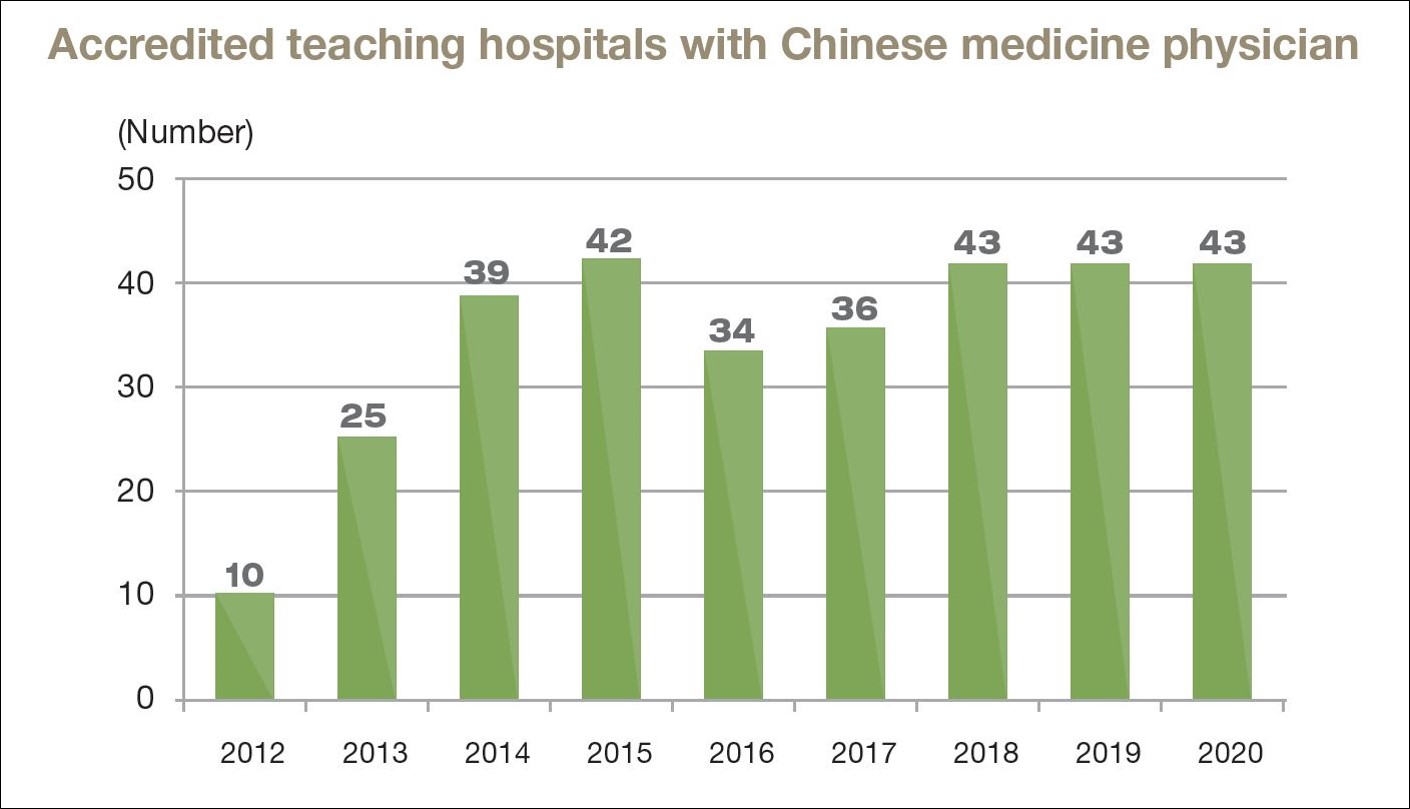
Figure 2-5: Number of accredited hospitals with Chinese medicine physicians over the years
Section Four: The Growth of Chinese Medicine Health Care Institutions
The Ministry encourages general hospitals to set up departments of Chinese medicine in order to provide both Western medicine and Chinese medicine in parallel toward better public health care and prevention. Also, setting up a department of Chinese medicine will promote the integrated development of Western medicine and Chinese medicine. The number of Chinese medicine institutions has been gradually growing over the past ten years. As of the end of 2019, there are a total of 4,070 Chinese medicine institutions in Taiwan, including 4 Chinese medicine hospitals, 3,944 Chinese medicine clinics and 122 hospitals with a department of Chinese medicine.
Currently, NHI covers only Chinese medicine outpatients, whereas Chinese medicine inpatients are not covered. Therefore, the number of Chinese medicine hospitals decreased from 44 hospitals in 2001 to 4 hospitals in 2019; meanwhile, the number of Chinese medicine clinics increased each year from 2,544 clinics in 2001 to 3,944 clinics in 2019. The number of hospitals with a Chinese medicine department also increased from 59 hospitals in 2001 to 122 hospitals in 2019, as shown in Figure 2-6.
Figure 2-6: Chinese medicine health care institutions growth trend over the years
Section Five: Diverse Developments in Chinese Medicine
With advances in medical care, the life expectancy of Taiwanese citizens is also increasing. In order to meet the public's medical care needs and improve Chinese medicine health care quality, the Ministry has begun promoting the characteristics of Chinese medicine and diversified medical care, including a "Western/Chinese Medicine Cooperation Health Care Model" (2013), a "Chinese Medicine Day Care Mode" (2014) and a "Chinese Medicine Involvement in Long-Term Care Service Model" (2015). Furthermore, in implementing the Executive Yuan's "Let's Be Drug Free Anti-Drug Campaign" policy, the "Chinese Medicine Involvement in Drug Rehabilitation and Therapy Mode" was augmented in 2016. Over years of hard work, the Ministry has established these various models to provide the public with diverse medical care alternatives. The process of promoting diversified Chinese medicine health care models is illustrated in Figure 2-7, and the various activities are summarized in Figure 2-8. The achievements over the years are as follows:
-
Western/Chinese Medicine Combined Care Model: 10 distinct versions of this model have been established in outpatient departments, emergency rooms, and wards (with treatment of head and neck tumors, vertigo emergencies, pain emergencies, chronic wounds, reflux esophagitis, precocious puberty, atopic dermatitis, bowel obstruction, allergic rhinitis complicated by sleep disturbance, and delayed gastric emptying). In particular, emergency treatment of vertigo, pain and bowel obstruction will be incorporated into the NHI trial plan in 2018.
-
Chinese Medicine Day Care Model: This model has been established for 11 kinds of illnesses (pediatric asthma, endometriosis/dysmenorrhea, stroke sequelae, dementia, chronic kidney disease, diabetic kidney disease, esophageal cancer, breast cancer, colorectal cancer, bladder cancer and sports injury/lower back pain).
-
Chinese Medicine Involvement in Long-Term Care Service Model: This model has been established in 3 different settings (nursing homes, retirement homes, and home care centers).
-
Chinese Medicine Involvement in Drug Rehabilitation and Therapy Model: This model has been established for 5 applications (auriculotherapy, laser acupuncture, transcutaneous electrical nerve stimulation, acupressure ear magnets, and laser meridian massage).
Figure 2-7:Progress of promoting diversified Chinese Medicine Care Models
Figure 2-8:Photo of diversified Chinese medicine care activity




